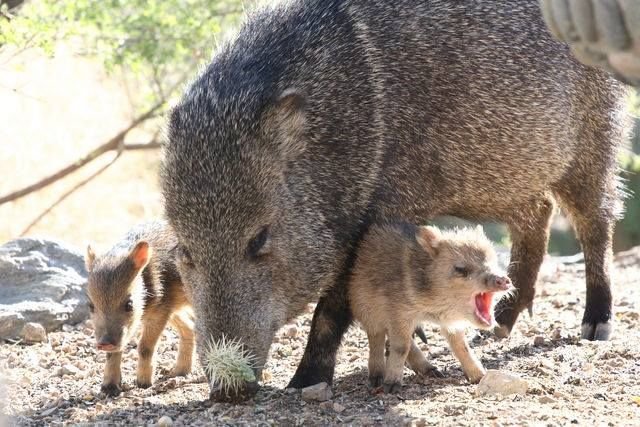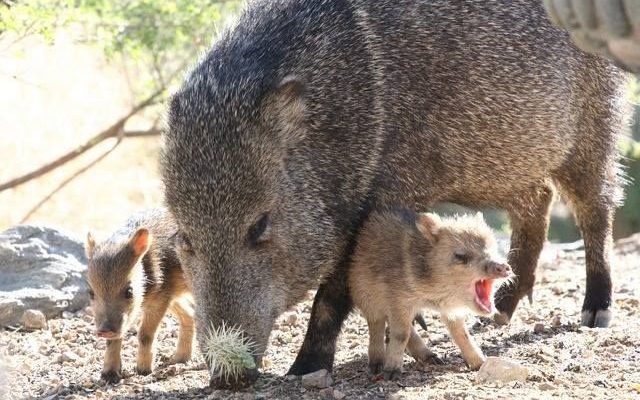
Javelinas, or peccaries as they’re also known, are often confused with pigs. While they do share some traits, they’re their own distinct creatures. Imagine them as the quirky cousins of the swine family, offering a mix of similarities and differences. In this article, we’ll explore some common myths and misconceptions about javelinas, helping you gain a clearer understanding of who they are and how they fit into the world around them.
Myth 1: Javelinas Are Dangerous to Humans
One of the biggest myths surrounding javelinas is that they’re aggressive and dangerous to humans. Picture this: you’re hiking in the desert and spot a javelina. You might feel a rush of fear, thinking it could charge at you. Here’s the thing: while javelinas can defend themselves if they feel threatened, they’re generally not a danger to people unless provoked. They’re more scared of us than we are of them!
Javelinas are herbivores, feasting mostly on plants, fruits, and roots. Their diet keeps them busy foraging and minding their own business, which means they’re typically not looking to pick fights. If you encounter one, give it space and observe from a distance. They’re more likely to run away than confront you. So, while they have tusks and can bite if frightened, it’s not something you need to fear on your average camping trip.
Understanding Their Behavior
Javelinas are known for being social animals, often traveling in groups called sounders. This is one area where things can get a bit tricky. If you accidentally come between a mother and her young, that’s when you might see some defensive behavior. But remember, most of the time, they’d rather avoid you altogether.
The key takeaway? If you respect their space and don’t approach them, you can watch these quirky animals without any worries.
Myth 2: Javelinas Are Pigs
Another common misconception is that javelinas are just wild pigs. While javelinas and pigs belong to the same order, Artiodactyla, they’re actually quite different. Think of it this way: just because a cat has four legs and a tail doesn’t mean it’s the same as a dog. Javelinas are part of the family Tayassuidae, while domestic pigs belong to the family Suidae.
One of the most notable differences is how they look. Javelinas have a more slender body, shorter legs, and a unique scent gland on their backs. This gland allows them to mark their territory—something pigs don’t do. Plus, javelinas have a more pronounced snout and tusks that can grow over time, giving them a more distinct appearance.
Dietary Differences
Speaking of diets, javelinas eat differently from pigs too. While pigs may enjoy a variety of foods, including leftovers from human meals, javelinas are strict herbivores. They munch on cacti, roots, fruits, and grasses, which helps sustain their bodies and keep their energy levels up.
So, next time you hear someone call a javelina a pig, you can confidently correct them. They might share some similarities, but these fascinating creatures deserve their own identity.
Myth 3: Javelinas Are a Threat to Livestock
If you’ve heard that javelinas are a menace to livestock, there’s some truth mixed with a whole lot of exaggeration there. Let’s set the record straight: while javelinas might nibble on crops or garden plants, they’re not typically a danger to larger farm animals.
They tend to prefer browsing on native vegetation rather than raiding barns or attacking livestock. Farmers might worry about losing some fruits or vegetable crops, but livestock is usually safe. In fact, many ranchers who coexist with javelinas report little to no significant damage to their animals.
Understanding Their Role in the Ecosystem
It’s essential to look at javelinas as part of a larger ecosystem. They help maintain plant populations by consuming certain plants, which can promote new growth. Think of them as nature’s little gardeners. By spreading seeds and keeping plant life in balance, they play a vital role in their environment.
So while they might occasionally munch on a garden, they’re more beneficial than harmful in the grand scheme of things.
Myth 4: Javelinas Are Nocturnal Creatures
You might think javelinas are night owls since they’re often spotted at dawn or dusk. But here’s the truth: they’re not strictly nocturnal. They’re actually crepuscular, which means they’re most active during the twilight hours. It’s like they have a special preference for the golden glow of early morning or the soft hues of the evening.
During the warmer parts of the day, javelinas tend to relax in shady spots to escape the heat. They enjoy staying cool and conserving energy, which is quite smart when you think about it. So, if you’re hoping to see them, consider early morning or late afternoon as your best bets.
Adapting to Their Environment
Living in the desert means dealing with harsh conditions. Javelinas have adapted incredibly well to this environment. Their crepuscular nature is an important survival strategy, allowing them to forage for food when temperatures are milder. This adaptability is just one of the many reasons they thrive in the wild.
Understanding their behaviors helps us appreciate how unique and well-suited javelinas are to their habitats.
Myth 5: Javelinas Spread Disease
Another concerning myth is that javelinas spread diseases like rabies or swine fever. While it’s true that any wild animal can carry diseases, the worry about javelinas being major carriers is largely exaggerated. In fact, rabies is relatively rare in javelinas. They’re not a primary vector for widely feared diseases, which means the risk of contracting something from them is low.
Like all wild animals, they can carry parasites—such as ticks or worms—but that’s true for many species. Just like we wouldn’t avoid all domestic animals because of a slim chance of disease, it’s important not to paint javelinas with the same broad brush.
Wildlife Management and Awareness
To keep things in perspective, proper wildlife management can help mitigate any actual diseases in javelina populations. Many regions have wildlife programs that monitor animal health and educate the public on how to coexist peacefully with these creatures.
So, the next time you hear someone express fear about diseases from javelinas, remind them that education and understanding go a long way in keeping both humans and wildlife safe.
Javelinas are quirky, misunderstood animals that play an essential role in their ecosystems. By debunking common myths, we can foster a greater appreciation for these unique creatures. They deserve respect for their role in nature, and understanding them can help bridge the gap between humans and wildlife.
Next time someone brings up javelinas at a coffee chat, you’ll have some solid facts to share! Whether they’re foraging through the desert or simply trying to survive the heat, let’s celebrate these captivating animals and the beauty of nature they represent.

